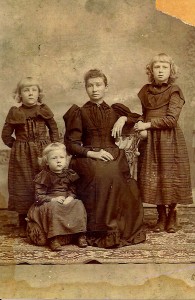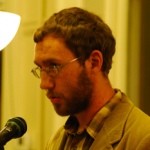By Miscellaneous Authors
Emily Johnston’s series “Traumatic Emplacement” explores poetics of emplacement, and the simultaneity of dislocation and enmeshment in traumatic poetry.
In Emily Johnston’s previous blog post, “Traumatic Emplacement: Poetry Emplaces Violence,” she talks about pedagogical strategies for teaching trauma and poetry in relation to one another. Specifically, she writes about teaching with Women Write Resistance: Poets Resist Gender Violence, an anthology of poems about gender violence in the United States by more than 100 North American women poets. That blog post helped to establish a relationship between SRPR, Laura Madeline Wiseman (the anthology’s editor), and several of the poets featured in the anthology, which prompted them to dialogue more about connections they see among teaching, resistance poetry, and SRPR’s poetics of emplacement. This roundtable blog is a result of that dialogue—hopefully one of many more results to come.
Emily Johnston: Spoon River Poetry Review defines poetics of emplacement as “writing that reveals the borders of our comfort zones as sites of connection rather than irreconcilable difference.” Speak about your experiences in teaching poetry that explores issues of gender violence and resistance. How have these pedagogical moments created connections, even as they moved the borders of such comfort zones? In your answer, also discuss texts that foster such exploration of a poetics of emplacement.
Jehanne Dubrow: One of the poems that I often teach (particularly to students in the introductory creative writing classroom) is Rita Dove’s “Adolescence II.” It’s a poem that explores gender violence through a set of terrifying images, which students often describe as “trippy” or “fantastical.” Initially, students struggle with moments like “Then they come, the three seal men with eyes as round / As dinner plates and eyelashes like sharpened tines” and “I clutch at the ragged holes / They leave behind, here at the edge of darkness.”
This is a text that tends to divide the classroom along gender lines. Male students often reject the idea that the speaker in the poem has constructed a beautiful-grotesque idiom—surreal and alienating—as testimony to a violence she has experienced. They want to label the poem a dream or hallucination, rather than imagine that the narrative of a girl trapped with menacing men might be real. Meanwhile, female students will frequently edge toward a cautious, nervous reading of the poem: has something terrible been done to this young woman?
The poem doesn’t offer up its answers easily, which in turn teaches the students about the relationship between form and content. Poems about gender violence may appear to speak with difficulty, may stutter or stumble, may be forced to find a new language to communicate experience, and to reflect how violence simultaneously urges us toward silence and speech.
Emily Johnston: I can definitely hear, in your description of students’ responses dividing along gender lines, how Dove’s poem reveals the borders of our comfort zones and how those borders themselves are often divided along gender lines. My teaching experience has also revealed how female students often feel hypervigilant about protecting women’s bodies from an ever-present threat of violence, while male students often feel hypervigilant about safeguarding male identities as “protectors” and “providers,” which can make recognizing men’s pervasive violence against women nearly impossible for them.
Lisa Lewis: This semester I am using Women Write Resistance in an advanced undergraduate poetry writing class. I wish I could say it was easy to cross that border from the poems about gender violence to my students, who have mostly grown up in Oklahoma. I have to find new patience and new questions to ask whenever the topic of discussion is one of those concerns that are held as if paralyzed in amber—visible, but untouchable—by the prevailing majority views here: gender, race, class. The moments one hopes for, when a woman might, for instance, experience herself in the presence of enough empathic support to speak with understanding about the poem, or herself in its context, are fleeting, often hardly discernible. One learns to identify small signs. Students try to catch my eye when someone dismisses or denies on sexist grounds they dare not call “sexist.” They’re not ready to fight, but they mean to encourage me. That’s how bad it can be here: women still smile constantly—not convincingly—to buy their right to live in relative peace among people who want them to present themselves as living a perfect life. What their eyes say is unsmiling, guarded. I look to their eyes, the look in their eyes.
That’s why those of us who teach poetry—feminist poetry, any good poetry at all—in areas like this are doing such necessary work, if apparently uncommon ourselves. Even in the face of discouragement, connection does happen. Young women can find a way to escape what harms them. They can make art that will open to them a way to speak, and then to act, to save themselves and others. It is a lifelong process for us all—to recognize, to write, to push forward into action.
Emily Johnston: Thank you so much, Lisa, for your inspiring vision of teaching poetry as activist work, particularly in a global moment when so-called social advancements (technologies, economies, etc.) threaten connection at every turn.
Laura Madeline Wiseman: One text I’ve taught is Anne Sexton’s Transformations, a collection introductory poetry students seem to be able to approach because they feel they can grasp the content. Having a text in common—Sleeping Beauty, Rumpelstiltskin, Twelve Dancing Princesses and it’s various contemporary depictions in Disney, cartoons, children’s books, toys, contemporary flicks, etc.—and whether or not the students have read Grimm, allows most to connect on the level of story and then to move to other questions such as delivery, craft, allusions, form, and interpretation. Some students stay there, in the retellings and the craft, not probing into interpretation, why Sexton might portray Sleeping Beauty’s father in a given light, while others question the imagery and word choice, asking, “Is this poem about incest?” It is these questions that move the edges of border zones and allow the class to connect on various ways to read poetry.
Another tool I bring into the classroom to help students grapple with larger issues of gender violence and its representation in literature is the Power and Control Wheel, asking students to find examples (e.g. emotional abuse, using children, making her think she’s crazy) in a text that illustrates the ways in which an abuser maintains control before resorting to physical and sexual abuse. It’s always a powerful discussion because students examine the edges of their knowledge of what constitutes family violence and what it means to the reader of poetry and literature. Students are often shocked to compile the examples abusers use to maintain power, a process and discussion that gives them the opportunity to rethink their interpretations of texts such as The Twilight Series, Jane Smiley’s One Thousand Acers, Joy Castro’s The Truth Book, and Sexton’s Transformations.
Emily Johnston: Yes! I too find the Power & Control Wheel helpful for teaching students to think about gender violence as a manifestation of power and control. I’d be interested in talking more about “what it means to the reader of poetry and literature.” Perhaps a future blog topic…
Grace Bauer: I like this word “emplacement” as a descriptor for that transformative thing that poetry can do. Poetry doesn’t just give us information about an experience, but can also recreate experience in a way that allows the reader to enter into it, even if that experience is beyond the scope of their own lives. As a teacher, I’ve seen this happen many times – especially with undergraduates who may be new(er) to poetry that deals with violence or controversial issues.
The poems that first come to mind are not about gender violence, per se, but an aspect of (some) women’s experience that tends to polarize – namely, abortion. Most students will readily identify themselves as pro-something or anti-something on this issue, but then we’ll read poems by Anne Sexton and Lucille Clifton and Gwendolyn Brooks – and I’ll ask “Are these anti-abortion poems or pro-choice poems?” and most of the students will recognize that they are neither, that the poems don’t so much take sides on this highly politicized issue as put you inside the speaker’s mind, the woman’s dilemma, the can’t win of this particular hard choice.
I also think of books that focus on large-scale violent events — like Brian Turner’s Here Bullet (about the war in Iraq) or Bob Hicok’s Words For Empty, Words For Full (largely about the Virginia Tech shootings). Students have read about these events, they have watched reports on the news, but many of them will say that the poems do a better job of conveying what the lived experience must have felt like, even better than the graphic images they may have seen on the big or little screen.
Students — all readers — know that gender violence exists. We know – intellectually – that it’s a terrible thing, but poems like those in Women Write Resistance can take us inside that experience. “Emplace” us there. And, hopefully, elicit empathy. And further resistance.
Emily Johnston: So well said, Grace. Healing—especially from such an isolating trauma as abortion—becomes possible when others bear witness to our lived experiences.
Monica Wendel: As a professor of composition and creative writing, my course load is primarily English 101 and 102 classes. It’s the class where, among other things, you learn to read in a new way – not just for answers, but for understanding, nuance, and analysis.
It is also the case that resisting gender violence also involves a different way of reading: a different way of reading catcalls and whistles; a different way of reading Huffington Post articles on war; a different way of reading sexual assault prevention tips; a different way of reading advertisements for children’s toys.
In a perfect world, one act would lead quite simply to the other. Analyzing literature would lead to analyzing the world around us, and vice versa. However, any piece of writing that treats women as fully-formed, dimensional characters, capable of independent thought and action, is writing that discomforts a large number of my students. Before students can explore issues of gender violence and resistance, my challenge is for them to acknowledge that gender violence exists, period.
We dive down “into the wreck,” as Adrienne Rich says, or trace the fairy tales and nightmares embodied in Ralph Ellison’s “Invisible Man.” We find the diamond “in a knot of flame,” as Audre Lorde writes.
I have no idea if, or how, these pedagogical moments create connections or move the borders of comfort zones, but they are necessary in order for students to look at all characters as human, first and foremost. As Henrick Ibsen said, “Whatever I have written has been without any conscious thought of making propaganda. … I am not even quite clear as to just what this women’s rights movement really is. To me it has seemed a problem of humanity in general.”
Emily Johnston: The theme of reading keeps surfacing in our conversation here. Before students become ready to accept the deep roots of patriarchy that continue to anchor our political, economic, medical, and educational systems (in addition to countless other social institutions), they need to understand the central role that reading (texts, body language, media, casual conversations, etc.) can play in transforming the world.
Tyler Mills: I’ve had productive conversations about gender violence and resistance in workshop when teaching the poetry of Sylvia Plath. After asking students “what they know” about Plath’s life—her famous tragic ending—and letting them talk it out for a minute or two, I urge them instead to think about how Plath’s work functions on the level of motif, metaphor, even mid-twentieth century artifact. This might seem like a no-brainer, but it is really hard to get students to make this switch. “Irreconcilable differences” that many students initially bring to a poem such as “Lady Lazarus” (statements about how “messed up” the poem is, how “depressed” the poet must have been, even how she must “hate men”) begin dissolving. Students start analyzing the terrifying imagery rather than assessing it as something “other” to their experience in the world. It is when we acknowledge the well-known details of Plath’s life, and talk about what Confessionalism was and meant for a core group of writers like her in the mid-twentieth century, that we can instead turn to the speaker as a persona: one very much like the personae that speak from the position of the lyric “I” in many other poems that deal with violence. Acknowledging the life but then choosing to focus on the art shows students how brilliant a poet Plath was—a genius, really. She deserves to be taught that way rather than to have students hunt for her “head in the oven.” I like talking about Confessionalism in relation to (and in tension with) Louise Glück’s essay, “Against Sincerity” (Proofs and Theories). And the next time I teach Plath, I’d like to also assign B.K. Fischer’s fascinating contribution to the Los Angeles Review of Books “Poet’s Roundtable on Person and Persona” from this past October: “Proximity, Proxy, Practice.”
Emily Johnston: Again, the theme of reading surfaces—here, as a means of moving from othering to connecting.
Rosemary Winslow: Teaching a junior level course to majors from every discipline at the university last spring, I noted a sea change in greater understanding of the experiences of gendered cultural forces. The evidence was most marked in responses to Adrienne Rich’s essay, “When We Dead Awaken.” To my great surprise, and counter to my experiences of previous decades, students understood, with palpable compassion, the violence to the self as Rich considers having no place or voice for a female self. One young man wrote in an essay of his own that he identified with Rich’s position as he and other men now have to forge their own identities in the economic and social domains. He and other men, along with the women in the class, were highly vocal–often horrified–on reading poetry expressing gender violence. The women and the men in the class spoke frequently of the damaging acts recounted in such poems, offering at the same time ways the actions of characters in poems could have made a fine and loving relationship. The poems opened up gender forces to view for response, discussion, understanding, change. Poets whose work surmounted sheer violence with expressions of love and strong positive action were especially highly valued–Audre Lourde’s “Coal” and “Black Mother Woman” were favorites. Other poems that conveyed women’s strength and power included Adrienne Rich’s essay named above and “Diving into the Wreck” and “Power.”
Emily Johnston: Rosemary, what a hopeful message! I think that one of our biggest challenges—not just as poets and teachers, but as human beings—is finding ways to face violence with compassion; to allow violence to open us to recognizing our inevitable, irreversible connections with one another. I’m thinking especially of Judith Butler’s call for interdependence as the basis for global community in Precarious Life: The Powers of Mourning and Violence.
Jennifer Perrine: “Course, Interrupted”: For nearly ten years, I’ve taught at least one course on poetry every semester. In these classes, poems that explore and resist gender violence often appear, but not because I assign them. I don’t ask students to write about particular issues, and yet students write poems about gender violence every semester, every year. Perhaps some students feel safe writing about gender violence because they know that I also direct and teach in the women’s and gender studies program at our university. Mostly, though, I suspect they recognize, as Richard Hugo put it, that the “creative-writing class may be one of the last places you can go where your life still matters,” so they share truths from their lives in a way they might not in other spaces.
When students write these poems, the rest of us are often pushed to a learning edge where we must reckon with a reality we’ve ignored, forgotten, or never recognized in the first place. Though some of us may have once believed our lives were not affected by gender violence, we are now touched by it, by this person who sits beside us for three hours each week. When one person dares to resist gender violence by breaking the silence around it, our classroom community always changes. We still read, write, and talk about poetry, but now we also question gendered assumptions, roles, and systems. We ask how poetry can be a form of witness, action, and resistance. One brave student writes a poem, and we all come to understand that the work of our class is not only to learn about poetry, but also to respond to the reality of violence in the lives of those around us with care, support, respect, and—dare I say it?—love.
Emily Johnston: Say it, sister… love!
Sarah Chavez: It was a first year rhetoric and inquiry class focused on the topic of American identity. For that particular day we read Lucille Clifton’s shapeshifter poems, a series about a young girl being molested by her father. The usually talkative students were quiet, squirmy, refusing eye contact. The resistance in the room was palpable.
They had no trouble talking about the graphic violence in Fight Club, no qualms about the joblessness, depression, and naked vulnerability in Philip Levine’s poetry, but this pushed their comfort level. Clearly a line had been crossed. Finally, a male student blurted out, “I just don’t understand what this has to do with American identity.” A chorus of “yeahs” erupted, vehement head nodding. His outburst broke the silence perfectly. It invited the question, what makes something American? That was safer to focus on.
“Because it happened in the U.S.?” someone said.
“Because the writer is American?”
“Sure,” one student said, “but who wants to talk about this stuff? No one.”
Another responded, “I guess, maybe, that’s what it’s about though, that the little girl can’t tell anyone.”
“Yeah,” said another. “It’s ‘the poem the little girl breathes / into her pillow” because “there is no one to hear.’”
Exactly, I said. But now you’ve heard.
That is poetry’s power. Our classroom transformed into a place of witness. For at least half an hour, the students considered the trauma and sexual violation of one person as inextricably connected to our collective consciousness as a nation. It is impossible to truly teach witness, but we must create spaces where it is invited. I am deeply grateful for poetry like Clifton’s, as I am for Laure-Anne Bosselaar, Rigoberto Gonzalez, and so many others; their words make this possible.
Emily Johnston: What strikes me too, Sarah, is how even a student’s initial declaration, “I just don’t understand how this is relevant,” is both evidence of a pervasive, impermeable boundary around some new thing students encounter in the classroom (in this case, Clifton’s poetry), AND of a simultaneous desire and need to push beyond that boundary.
Thank you so much, Jehanne, Lisa, Madeline, Grace, Monica, Tyler, Rosemary, Jennifer, and Sarah. Your words have brought up some vital points about our roles and responsibilities as writers and teachers of poetry. I look forward to continuing our dialogue!
≅
Emily R. Johnston is a Doctoral student in English at Illinois State University, and she is a Senior Editorial Assistant of SRPR. Emily earned her MFA from the University of Alaska Fairbanks. Her creative and critical work appears in Antipodes: A Global Journal of Australian/New Zealand Literature, The Fourth River, and Dos Passos Review, among others. Emily eventually hopes to build “Therapy House” where victims of violence can explore arts, movement, and collaborative activities as tools for recovery.
Rosemary Winslow lives in Washington, D.C., and teaches at The Catholic University of America. Her book Green Bodies expressed and grappled with the complexities of love in troubled families, and sought understanding, forgiveness, and compassion for the wide circle of humankind. She has taught in shelters for women, and now enjoys yoga, hiking, swimming, kayaking, and singing in a choir.
Tyler Mills is the author of Tongue Lyre, which won the 2011 Crab Orchard Series in Poetry First Book Award (SIU Press, 2013). Her poems have received magazine awards from the Crab Orchard Review, Gulf Coast, and Third Coast. A graduate of the MFA program in creative writing at the University of Maryland, she is currently pursuing a PhD in the Program for Writers at the University of Illinois-Chicago.
Sarah A. Chavez is a mestíza born and raised in the California Central Valley completing her PhD in poetry and Ethnic Studies from the University of Nebraska – Lincoln. Her work can be found in various publications such as Not Somewhere Else But Here: A Contemporary Anthology of Women and Place, the journals North American Review, The Fourth River, and others. Her chapbook All Day, Talking is forthcoming from dancing girl press in summer 2014.
Jennifer Perrine is the author of The Body Is No Machine (New Issues), winner of the 2008 Devil’s Kitchen Reading Award in Poetry, and In the Human Zoo (University of Utah Press), recipient of the 2010 Agha Shahid Ali Poetry Prize. In 2014, she will serve as a member of the U.S. Arts and Culture Delegation to Cuba. Perrine teaches in the English department and directs the Women’s and Gender Studies program at Drake University.
Grace Bauer’s newest book of poems is Nowhere All At Once, just out from Stephen F. Austin State University Press. Her previous books include Retreats & Recognitions, Beholding Eye, and The Women At The Well, as well as four chapbooks, most recently, Café Culture, from Imaginary Friend Press.
Monica Wendel is the author of No Apocalypse (Georgetown Review Press, 2013) and the chapbooks Pioneer (Thrush Press, forthcoming June 2014) and Call it a Window (Midwest Writing Center, 2012). She is assistant professor of composition and creative writing at St. Thomas Aquinas College.
Jehanne Dubrow is the author of four poetry collections, including most recently Red Army Red and Stateside. Her fifth book of poems, The Arranged Marriage, will be published in 2015. She is the Director of the Rose O’Neill Literary House and an Associate Professor of creative writing at Washington College.
Lisa Lewis’ books are The Unbeliever, Silent Treatment, Vivisect, and Burned House with Swimming Pool, as well as a chapbook titled Story Box. She was the 2011 recipient of a National Endowment of the Arts Fellowship. She directs the creative writing program at Oklahoma State University and serves as poetry editor of the Cimarron Review.
Laura Madeline Wiseman’s books are Some Fatal Effects of Curiosity and Disobedience, Queen of the Platform, and Sprung. She is also the author of the collaborative book Intimates and Fools with artist Sally Deskins, two letterpress books, and eight chapbooks, including Spindrift. She is the editor of Women Write Resistance: Poets Resist Gender Violence. www.lauramadelinewiseman.com
 Rob Koehler is a second year doctoral student in English at New York University and has an abiding interest in the processes and peculiarities of teaching reading, especially reading literature of all sorts, in the classroom. He blogs at Reading.Text.Book.History. on all things related to education, textbooks, and reading.
Rob Koehler is a second year doctoral student in English at New York University and has an abiding interest in the processes and peculiarities of teaching reading, especially reading literature of all sorts, in the classroom. He blogs at Reading.Text.Book.History. on all things related to education, textbooks, and reading.






